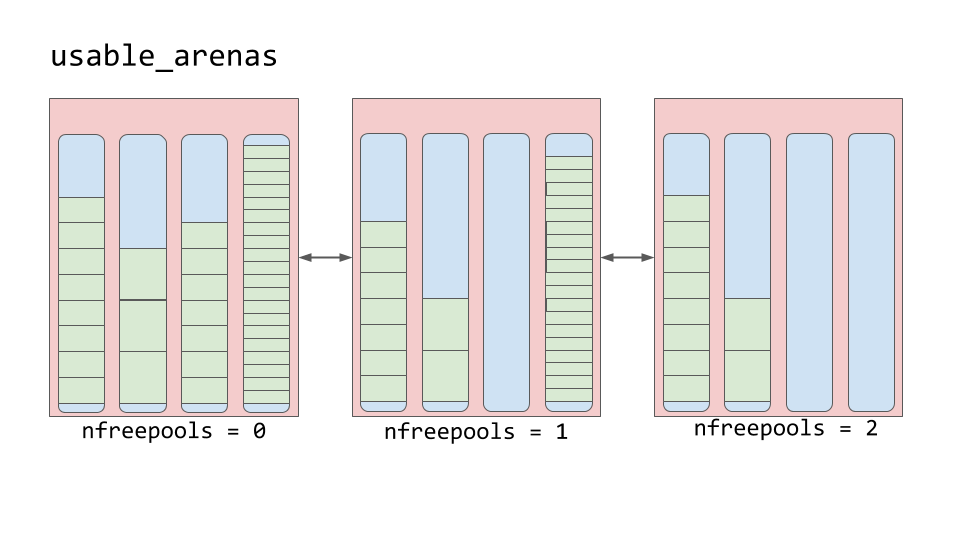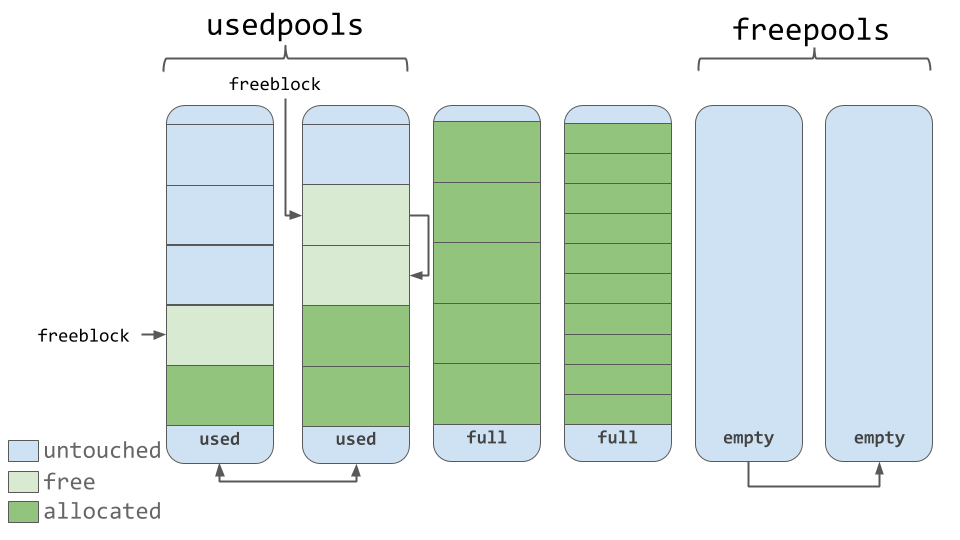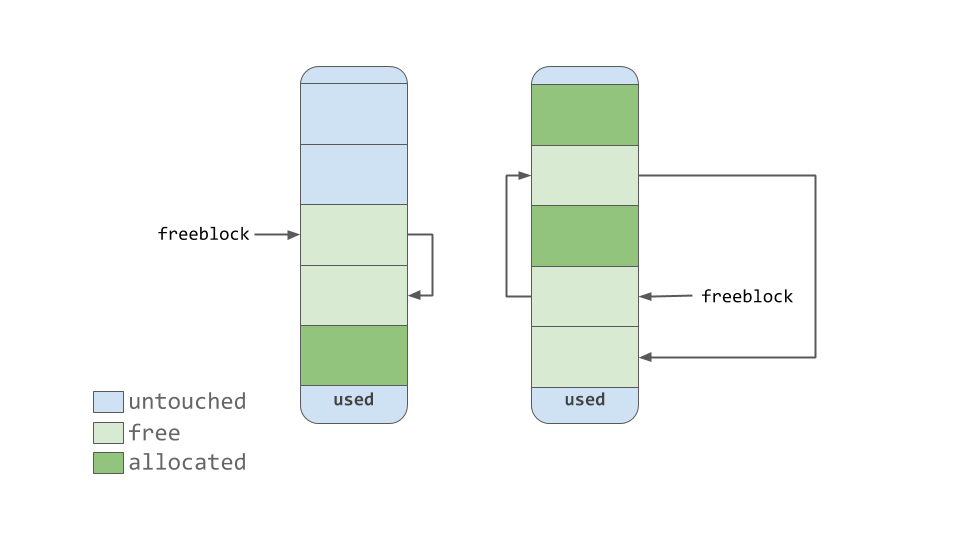CPython Internals: Memory Allocation
CPython has several memory allocators, intended to used for different domains. pymalloc is the main allocator that operates differently from well-known malloc and free.
All codes in this post are based on CPython v3.10.
Review: Memory Layout of Linux Process

Each process has the same uniform view of memory, which is known as its virtual address space. The virtual address space seen by each process consists of a number of areas, each with a specific purpose. When programs require more memories, they request an additional memory area, usually located between the user stack and the program data.
Linux provides two system calls for this purpose:
sbrkchanges the break pointer, so the program can use the so-called heap area (the area between the break pointer and the program data).mmapexplicitly request a new memory area.
Most C Programs use the malloc and free to dynamically manage the additional memory, which internally uses sbrk. However, CPython uses a different approach called pymalloc.
Allocator Domains of CPython
All allocating functions of CPython belong to one of three different domains (see Include/cpython/pymem.h:L23-L32 for details)
- Object domain: intended for Python objects.
- "Mem" domain: intended for Python buffers and general-purpose memory buffers where the allocation must be performed with the GIL held.
- Raw domain: intended for general-purpose memory buffers where the allocation must go to the system allocator or where the allocator can operate without the GIL.
These domains represent different allocation strategies and are optimized for different purposes. Internally, CPython uses two functions to take a memory; system's malloc and Python's pymalloc.
| Configuration | Raw domain | "Mem" domain | Object domain |
|---|---|---|---|
| Release | malloc | pymalloc | pymalloc |
| Debug | malloc + debug | pymalloc + debug | pymalloc + debug |
| Release, w/o pymalloc | malloc | malloc | malloc |
| Debug, w/o pymalloc | malloc + debug | malloc + debug | malloc + debug |
pymalloc is optimized for small objects (smaller or equal to 512 bytes) with a short lifetime. It falls back to malloc for allocations larger than 512 bytes.
Memory allocation algorithm of pymalloc
pyalloc first takes a large memory chunk from system, and internally manages all objects and data structures inside the chunk. The memory chunk is called an arena, and each arena consists of pools and blocks.
Arena

Arenas are the largest chunks of memory and are aligned on a page boundary in memory, where CPython assumes the system's page size is 256kB. Note that arenas are the only things that can truly be freed.
Arenas can be organized into a (doubly) linked list. In fact, CPython manages three lists of arenas:
arenas(Objects/obmalloc.c:L1212): list of all arenas.unused_arena_object(Objects/obmalloc.c:L1219): list of every empty arenas.usable_arenas(Objects/obmalloc.c:L1224): arenas with pools available, maintained in increasing order ofnfreepools(see next section for details).
struct arena_object {
uintptr_t address;
struct arena_object* nextarena;
struct arena_object* prevarena;
uint nfreepools;
/* ... */
};
New arenas can be allocated via new_arena() (Objects/obmalloc.c:L1533). When the new_arena() is initially called, it allocates 16 arenas, and doubles the number of arenas for each subsequent calls.
The arena allocator internally uses the following functions:
VirtualAlloc()/VirtualFree()on Windows,mmap()/munmap()if available,malloc()/free()otherwise.
Pools

An arena is composed of 64 pools (i.e., size of each pool is 4kB), where each pool can only store blocks with predefined sizes. For instance, if the size class index of a pool is 3, it can store only 25-32 byte of blocks. Each pool maintains a double-linked list to other pools of the same size class.
struct arena_object {
/* ... */
uint ntotalpools;
struct pool_header* freepools;
block* pool_address;
};
struct pool_header {
struct pool_header *nextpool; /* next pool of this size class */
struct pool_header *prevpool; /* previous pool "" */
uint arenaindex; /* index into arenas of base adr */
uint szidx; /* block size class index */
/* ... */
};
typedef struct pool_header *poolp;
Pools themselves must be in one of three states:
- Used: Some block is used and available blocks exist.
- Full: Every block is used so no available block exists.
- Empty: No data is stored, so any size class can be assigned.
To track the pool, CPython manages usedpools and freepools variables. When a given block size is requested, CPython checks available pools in usedpools. If no pool is found, initialize an empty pool in freepools with the size class and add to usedpools for its size class.
Blocks

Structure of blocks is simple; it's just a memory address.
struct pool_header {
/* ... */
union { block *_padding;
uint count; } ref; /* number of allocated blocks */
block *freeblock; /* pool's free list head */
uint nextoffset; /* bytes to virgin block */
uint maxnextoffset; /* largest valid nextoffset */
};
typedef uint8_t block;
Similar to the pool, blocks can have one of the three states:
- Untouched: Blocks have not been allocated.
- Free: Blocks had allocated but freed later by CPython.
- Allocated: Blocks allocated.
Note that each pool has a pointer freeblock. As CPython makes a block free, the block is filled with previous freeblock value while freeblock is filled with the address of this newly free block. In other words, freeblock points to a singly linked list of free blocks of the pool.
static inline void* pymalloc_alloc(void *ctx, size_t nbytes) {
if (UNLIKELY(nbytes == 0)) return NULL;
if (UNLIKELY(nbytes > SMALL_REQUEST_THRESHOLD)) return NULL;
uint size = (uint)(nbytes - 1) >> ALIGNMENT_SHIFT;
poolp pool = usedpools[size + size];
block *bp;
if (LIKELY(pool != pool->nextpool)) {
// used pool exists for this size class
bp = pool->freeblock;
assert(bp != NULL);
if (UNLIKELY((pool->freeblock = *(block **)bp) == NULL)) {
// exausted freeblock
pymalloc_pool_extend(pool, size);
}
} else { // no used pool exists; allocate new one from freepools
bp = allocate_from_new_pool(size);
}
return (void *)bp;
}
static void pymalloc_pool_extend(poolp pool, uint size) {
if (UNLIKELY(pool->nextoffset <= pool->maxnextoffset)) {
// untouched exists
pool->freeblock = (block*)pool + pool->nextoffset;
pool->nextoffset += INDEX2SIZE(size);
*(block **)(pool->freeblock) = NULL;
} else { // full pool; unlinked to usedpools
poolp next;
next = pool->nextpool; pool = pool->prevpool;
next->prevpool = pool; pool->nextpool = next;
}
}
Reference
- Randal E. Bryant and David R. O'Hallaron, Computer Systems: A Programmer's Perspective (3/E).
- Alexander VanTol, Memory Management in Python.